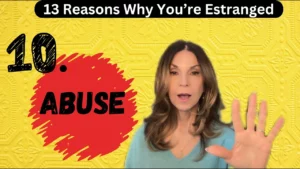Often considered an unbreakable bond, the parent-child relationship faces an unexpected and profound challenge in adult-child estrangement. This unanticipated deviation introduces a painful dynamic that intricately weaves through the fabric of familial connections. In this article, we will explore the depths of emotions surrounding adult-child estrangement, offering detailed insights to help navigate the web of grief and loss.
Understanding Adult Child Estrangement
Adult-child estrangement is a multifaceted phenomenon characterized by emotional or physical distance between grown children and parents. The reasons behind such estrangements are as diverse as the relationships themselves, ranging from unresolved conflicts to more severe issues such as abuse or addiction. To delve deeper into the complex motivations driving adult children to cut ties, refer to my in-depth video exploring the 11 reasons behind such decisions. Parents faced with this challenging situation often grapple with profound grief, a sentiment comparable to the mourning experienced when losing a physically present loved one.
The Grief Spectrum
The journey through grieving adult child estrangement unfolds in intricate stages, drawing parallels with the well-known Kübler-Ross model of grief. It commences with denial—a phase marked by initial disbelief, questioning how an unbreakable bond could rupture. This initial shock gives way to a surge of anger, a complex emotional response that may involve self-blame, directed resentment towards the child, or external factors. Bargaining follows a process of negotiations and the relentless replaying of scenarios in a desperate quest for solutions. As the weight of the estrangement settles in, depression takes hold, ushering in profound sadness and introspection. The final stage is acceptance, an acknowledgment of the estrangement as an irrevocable part of reality, prompting the search for ways to move forward.
Four Coping Strategies To Get You Through
- Seek Professional Support: The journey through adult child estrangement often necessitates a professional guide. Therapists, counselors, and support groups provide a haven for emotional navigation. Trained professionals, such as estrangement coaches, offer insights and coping mechanisms tailored to the intricacies of adult-child estrangement. Support groups specifically focused on this poignant issue become a source of community and shared wisdom.
In therapy, individuals can explore the depths of their emotions, identify coping strategies, and better understand their role in the estrangement. Therapists provide a non-judgmental space, guiding individuals through the complexities of grief and helping them build emotional resilience.
- Self-Care: The importance of self-care cannot be overstated. Beyond the basics, delve into activities that bring joy, relaxation, and a renewed sense of purpose. Engage in intentional self-care as a cornerstone for resilience during the tumultuous times that estrangement brings.
Self-care goes beyond mere relaxation—it involves rediscovering one’s passions and investing time in activities that foster personal growth. This might include pursuing hobbies, engaging in creative outlets, or dedicating time to physical well-being. By prioritizing self-care, individuals can strengthen their emotional foundations, making them more resilient in the face of estrangement-induced challenges.
- Open Communication (if possible): Open communication plays a pivotal role in the quest for healing. Approach conversations with empathy, understanding, and respect for boundaries. Authentic expression of feelings and active listening can create mutual understanding and resolution opportunities.
Communication is not just about talking; it’s about fostering genuine connection. When possible, engaging in open and honest conversations can be transformative. This involves active listening to the perspectives of both parties, acknowledging pain, and working towards understanding. It’s a delicate process that requires patience and a commitment to rebuilding fractured connections.
- Build a Support Network: Connection becomes a lifeline. Contact friends, family, or support groups to foster a profound sense of belonging. Shared experiences within these networks offer emotional support and practical advice on navigating the challenging terrain of adult-child estrangement.
Building a support network involves seeking solace and actively participating in the community. Attend support group meetings, share experiences, and contribute to the collective wisdom of those facing similar challenges. A supportive network becomes a source of comfort and a platform for shared growth and resilience.
Conclusion
The journey through adult child estrangement is undeniably complex and challenging, marked by the ebb and flow of grief. Recognizing the intricate stages of grief and implementing these detailed coping strategies pave the way for healing and personal growth. It’s imperative to remember that healing is a journey that unfolds at its own pace, and individuals are not alone in their experiences. Embracing these detailed coping strategies facilitates a transformative healing journey, acknowledging the profound complexity of emotions and fostering resilience in the face of adult-child estrangement. In the expansiveness of this journey, individuals can find not just recovery but a deep rediscovery of self and the potential for renewed connections.








